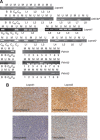The collagen prolyl hydroxylases are novel transcriptionally silenced genes in lymphoma
- PMID: 22955849
- PMCID: PMC3494450
- DOI: 10.1038/bjc.2012.380
The collagen prolyl hydroxylases are novel transcriptionally silenced genes in lymphoma
Abstract
Background: Prolyl hydroxylation is a post-translational modification that affects the structure, stability and function of proteins including collagen by catalysing hydroxylation of proline to hydroxyproline through action of collagen prolyl hydroxylases3 (C-P3H) and 4 (C-P4H). Three C-P3Hs (nomenclature was amended according to approval by the HGNC symbols and names at http://www.genenames.org/ and Entrez database at http://www.ncbi.nlm.nih.gov/gene) leucineproline-enriched proteoglycan (leprecan) 1 (Lepre1), leprecan-like 1 (Leprel1), leprecan-like 2 (Leprel2) and two paralogs Cartilage-Related Protein (CRTAP) and leprecan-like 4 (Leprel4) are found in humans. The C-P4Hs are tetrameric proteins comprising a variable α subunit, encoded by the P4HA1, P4HA2 and P4HA3 genes and a constant β subunit encoded by P4HB.
Methods: We used RT-PCR, qPCR, pyrosequencing, methylation-specific PCR, western blotting and immunohistochemistry to investigate expression and regulation of the C-P3H and C-P4H genes in B lymphomas and normal bone marrow.
Results: C-P3H and C-P4H are downregulated in lymphoma. Down-regulation is associated with methylation in the CpG islands and is detected in almost all common types of B-cell lymphoma, but the CpG islands are unmethylated or methylated at lower levels in DNA isolated from normal bone marrow and lymphoblastoid cell lines. Methylation of multiple C-P3H and C-P4H genes is present in some lymphomas, particularly Burkitt's lymphoma.
Conclusions: Methylation of C-P3H and C-P4H is common in B lymphomas and may have utility in differentiating disease subtypes.
Figures







Similar articles
-
Collagen Prolyl Hydroxylases Are Bifunctional Growth Regulators in Melanoma.J Invest Dermatol. 2019 May;139(5):1118-1126. doi: 10.1016/j.jid.2018.10.038. Epub 2018 Nov 16. J Invest Dermatol. 2019. PMID: 30452903 Free PMC article. Review.
-
Hypoxia-inducible factor-1 (HIF-1) but not HIF-2 is essential for hypoxic induction of collagen prolyl 4-hydroxylases in primary newborn mouse epiphyseal growth plate chondrocytes.J Biol Chem. 2012 Oct 26;287(44):37134-44. doi: 10.1074/jbc.M112.352872. Epub 2012 Aug 28. J Biol Chem. 2012. PMID: 22930750 Free PMC article.
-
Collagen prolyl 4-hydroxylase isoenzymes I and II have sequence specificity towards different X-Pro-Gly triplets.Matrix Biol. 2024 Jan;125:73-87. doi: 10.1016/j.matbio.2023.12.001. Epub 2023 Dec 9. Matrix Biol. 2024. PMID: 38081527
-
Tissue-specific collagen hydroxylation at GEP/GDP triplets mediated by P4HA2.Matrix Biol. 2023 May;119:141-153. doi: 10.1016/j.matbio.2023.03.009. Epub 2023 Mar 30. Matrix Biol. 2023. PMID: 37003347
-
Collagen prolyl 4-hydroxylases modify tumor progression.Acta Biochim Biophys Sin (Shanghai). 2021 Jul 5;53(7):805-814. doi: 10.1093/abbs/gmab065. Acta Biochim Biophys Sin (Shanghai). 2021. PMID: 34009234 Review.
Cited by
-
Protein arginine methyltransferase 5 regulates multiple signaling pathways to promote lung cancer cell proliferation.BMC Cancer. 2016 Aug 2;16:567. doi: 10.1186/s12885-016-2632-3. BMC Cancer. 2016. PMID: 27480244 Free PMC article.
-
Network pharmacological analysis of corosolic acid reveals P4HA2 inhibits hepatocellular carcinoma progression.BMC Complement Med Ther. 2023 May 29;23(1):171. doi: 10.1186/s12906-023-04008-6. BMC Complement Med Ther. 2023. PMID: 37248456 Free PMC article.
-
What a difference a hydroxyl makes: mutant IDH, (R)-2-hydroxyglutarate, and cancer.Genes Dev. 2013 Apr 15;27(8):836-52. doi: 10.1101/gad.217406.113. Genes Dev. 2013. PMID: 23630074 Free PMC article. Review.
-
Decitabine reactivated pathways in platinum resistant ovarian cancer.Oncotarget. 2014 Jun 15;5(11):3579-89. doi: 10.18632/oncotarget.1961. Oncotarget. 2014. PMID: 25003579 Free PMC article.
-
Prolyl 4-hydroxylase subunit alpha-2 acts as a TRIM21 ubiquitination substrate to promote papillary thyroid cancer progression via the glycolytic pathway.Cell Death Dis. 2025 May 17;16(1):395. doi: 10.1038/s41419-025-07702-0. Cell Death Dis. 2025. PMID: 40379610 Free PMC article.
References
-
- Baldridge D, Schwarze U, Morello R, Lennington J, Bertin TK, Pace JM, Pepin MG, Weis M, Eyre DR, Walsh J, Lambert D, Green A, Robinson H, Michelson M, Houge G, Lindman C, Martin J, Ward J, Lemyre E, Mitchell JJ, Krakow D, Rimoin DL, Cohn DH, Byers PH, Lee B (2008) CRTAP and LEPRE1 mutations in recessive osteogenesis imperfecta. Human Mutation 29(12): 1435–1442 - PMC - PubMed
-
- Belaud-Rotureau MA, Marietta V, Vergier B, Mainhaguiet G, Turmo M, Idrissi Y, Ferrer J, Beylot-Barry M, Dubus P, Merlio JP (2008) Inactivation of p16INK4a/CDKN2A gene may be a diagnostic feature of large B cell lymphoma leg type among cutaneous B cell lymphomas. Virchows Archiv Int J Pathol 452(6): 607–620 - PubMed
-
- Cabral WA, Chang W, Barnes AM, Weis M, Scott MA, Leikin S, Makareeva E, Kuznetsova NV, Rosenbaum KN, Tifft CJ, Bulas DI, Kozma C, Smith PA, Eyre DR, Marini JC (2007) Prolyl 3-hydroxylase 1 deficiency causes a recessive metabolic bone disorder resembling lethal/severe osteogenesis imperfecta. Nat Genet 39(3): 359–365 - PMC - PubMed
-
- Chaganti RS, Nanjangud G, Schmidt H, Teruya-Feldstein J (2000) Recurring chromosomal abnormalities in non-Hodgkin’s lymphoma: biologic and clinical significance. Sem Hematol 37(4): 396–411 - PubMed
Publication types
MeSH terms
Substances
Grants and funding
LinkOut - more resources
Full Text Sources
Miscellaneous

